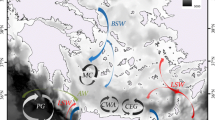Abstract
The hydrodynamics of Ems Estuary are dominated by tides and their interaction with buoyancy forcing. Such an environment is challenging for any effort to bring together observations and model results. In this study, we investigate how salinity measurements in the Ems Estuary affect the reconstruction of the salinity field. Similar to the traditional observing system experiments, the impact of specific observational arrays is simulated in the framework of statistical experiments. The experimental algorithm mainly relies on the model covariance matrix. Each experiment results in an estimate of the reconstruction error. The analysed observation configurations involve single and multiple, as well as stationary and non-stationary observing arrays. Generally, the reconstruction of the ocean state improves with increasing the density of observations. It appears that certain locations are more favourable for reconstruction than others. In fact, the regions separating the main dynamical realms resist strongest to the reconstruction effort. Extending the covariance matrix by the temporal cross-covariances between the model grid points enables to evaluate the impact of observations taken from a moving platform. This approach further improves the outcome of the experiments, resulting in reconstruction errors near zero with the exception of the tidal river. The cross-covariance information is able to tackle even the irregular dynamics arising on the border between the different physical regimes.













Similar content being viewed by others
References
Arnold J, Dey CH (1986) Observing-systems simulation experiments: past, present, and future. Bull Am Meteorol Soc 67:687–695
Ballabrera-Poy J, Hackert E, Murtugudde R, Busalacchi AJ (2007) An observing system simulation experiment for an optimal moored instrument array in the tropical Indian ocean. J Clim 20:3284–3299
de Boer GJ, Pietrzak JD, Winterwerp JC (2009) Sst observations of upwelling induced by tidal straining in the rhine rofi. Cont Shelf Res 29:263–277
Brasseur P, Verron J (2006) The seek filter method for data assimilation in oceanography: a synthesis. Ocean Dyn 56:650– 661
Cummings JA (2006) Operational multivariate ocean data assimilation. Technical Report. DTIC Document
Evensen G (2009) Data assimilation: the ensemble Kalman filter. Springer Science & Business Media
Grayek S, Schulz-Stellenfleth J, Stanev E (2015) Assessment of the black sea observing system. a focus on 2005–2012 argo campaigns. Ocean Dyn 99:999–9999
Grayek S, Staneva J, Schulz-Stellenfleth J, Petersen W, Stanev EV (2011) Use of ferrybox surface temperature and salinity measurements to improve model based state estimates for the german bight. J Mar Syst 88:45–59
Halliwell G, Srinivasan A, Kourafalou V, Yang H, Willey D, Le Hénaff M, Atlas R (2014) Rigorous evaluation of a fraternal twin ocean OSSE system for the open gulf of Mexico. J Atmos Ocean Technol 31:105–130
Hamill TM, Whitaker JS, Snyder C (2001) Distance-dependent filtering of background error covariance estimates in an ensemble Kalman filter. Mon Weather Rev 129:2776–2790
Houtekamer PL, Mitchell HL (1998) Data assimilation using an ensemble Kalman filter technique. Mon Weather Rev 126:796–811
Huijts K, Schuttelaars H, De Swart H, Valle-Levinson A (2006) Lateral entrapment of sediment in tidal estuaries: an idealized model study. Journal of Geophysical Research: Oceans (1978–2012) 111
Kalman RE (1960) A new approach to linear filtering and prediction problems. J Fluids Eng 82:35–45
Le Hénaff M, De Mey P, Marsaleix P (2009) Assessment of observational networks with the representer matrix spectra method application to a 3d coastal model of the bay of biscay. Ocean Dyn 59:3–20
Lermusiaux PF, Robinson A (1999) Data assimilation via error subspace statistical estimation. part i: theory and schemes. Mon Weather Rev 127:1385–1407
Ngodock HE, Jacobs GA, Chen M (2006) The representer method, the ensemble Kalman filter and the ensemble Kalman smoother: a comparison study using a nonlinear reduced gravity ocean model. Ocean Model 12:378–400
Oke PR, Sakov P (2008) Representation error of oceanic observations for data assimilation. J Atmos Ocean Technol 25:1004– 1017
Pein JU, Stanev EV, Zhang YJ (2014) The tidal asymmetries and residual flows in Ems estuary. Ocean Dyn 64:1719–1741
Schiller A, Wijffels S, Meyers G (2004) Design requirements for an argo float array in the Indian ocean inferred from observing system simulation experiments. J Atmos Ocean Technol 21:1598– 1620
Schulz-Stellenfleth J, Stanev E (2010) Statistical assessment of ocean observing networks—a study of water level measurements in the German bight. Ocean model 33:270–282
Talke S.A, de Swart HE, Schuttelaars H (2009) Feedback between residual circulations and sediment distribution in highly turbid estuaries: an analytical model. Cont Shelf Res 29:119–135
Tranchant B, Testut CE, Renault L, Ferry N, Birol F, Brasseur P (2008) Expected impact of the future smos and aquarius ocean surface salinity missions in the mercator ocean operational systems: new perspectives to monitor ocean circulation. Remote Sens Environ 112:1476–1487
Williamson D, Kasahara A (1971) Adaptation of meteorological variables forced by updating. J Atmos Sci 28:1313–1324
Williamson DL (1973) The effect of forecast error accumulation on four-dimensional data assimilation. J Atmos Sci 30:537– 543
Winterwerp JC (2011) Fine sediment transport by tidal asymmetry in the high-concentrated ems river: indications for a regime shift in response to channel deepening. Ocean Dyn 61:203– 215
Zhang Y, Baptista AM (2008) Selfe: a semi-implicit eulerian–lagrangian finite-element model for cross-scale ocean circulation. Ocean model 21:71–96
Acknowledgments
We want to thank Joseph Zhang (VIMS, USA) for his support of our work with the SCHISM model. We also want to thank Thomas Badewien (ICBM, Germany) for providing the data used in this study.
Author information
Authors and Affiliations
Corresponding author
Additional information
Responsible Editor: Alexander Barth
This article is part of the Topical Collection on the 47th International Liège Colloquium on Ocean Dynamics, Liège, Belgium, 4–8 May 2015
Rights and permissions
About this article
Cite this article
Pein, J.U., Grayek, S., Schulz-Stellenfleth, J. et al. On the impact of salinity observations on state estimates in Ems Estuary. Ocean Dynamics 66, 243–262 (2016). https://doi.org/10.1007/s10236-015-0920-0
Received:
Accepted:
Published:
Issue Date:
DOI: https://doi.org/10.1007/s10236-015-0920-0




